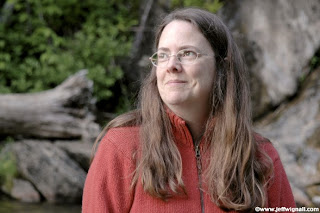 When I first got into digital photography I bought an Olympus C5050 camera that I still own and dearly love. It's a great 5 megapixel camera. One of the things I like about it is that the LCD is partially articulated--in other words, you can pull it away from the back of the camera body and angle it up. One of the many things that this makes it possible to do is to lay the camera on the ground and shoot up at low-lying subjects.
When I first got into digital photography I bought an Olympus C5050 camera that I still own and dearly love. It's a great 5 megapixel camera. One of the things I like about it is that the LCD is partially articulated--in other words, you can pull it away from the back of the camera body and angle it up. One of the many things that this makes it possible to do is to lay the camera on the ground and shoot up at low-lying subjects.The first summer I had that camera I crawled around on my back lawn and in my gardens looking for things I could shoot up at from ground level. The neighbors must have thought I was nuts (who cares!). One of my favorite subjects for shooting like this are the thousands of grape hyacinths that grow in my yard (I have more flowers than grass in my lawn, trust me). By just laying down with the camera and aiming it up slightly I was able to shoot these tiny flowers (about 4 inches tall) as if they were towering trees. I love the look of them. The articulated LCD isn't necessary, but in this case it just made it a bit easier to see the composition without pushing my face into the lawn.
I have since bought a Canon A650 that has a fully articulated LCD (you can even turn it backwards to you can shoot photos of yourself!) and I still really enjoy that feature. If you're thinking of buying a new point-and-shoot, consider that feature (especially if you're deciding between one camera that has it and one that doesn't). The ability to pull/twist/turn the LCD really has some nice benefits (like shooting over your head and still being able to see the image). But regardless of the camera, next time you're shooting flowers (soon I hope--we're supposed to get 14" of snow this weekend) try laying the camera on the ground and shooting up.
































